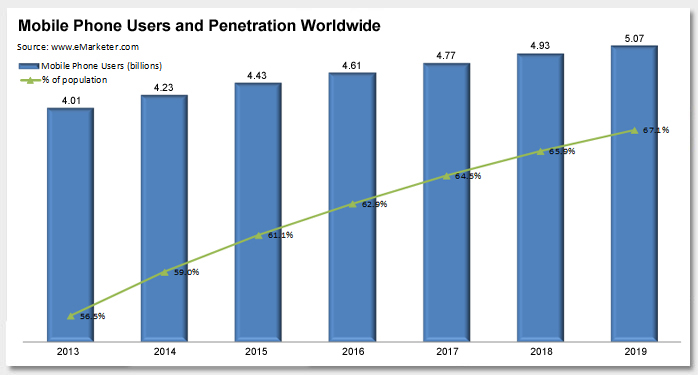We are all becoming increasingly reliant on our mobile devices. Not exactly a newsflash … but it’s not just us here in the United States. By some conservative estimates, the worldwide penetration of mobile phones will surpass 5 billion users, or approximately 67.1% of the world’s population, by 2019. Venture capital firm Kleiner Perkins (KPCB) estimates that in 1995, there were just 80 million mobile phone users, less than 2% of the population. That’s tremendous growth over a 24-year period. Of the mobile devices currently in use, KPCB (who estimates that we reached the 5 billion mark in 2014) figures that 40% of those devices are smartphones. This number will continue to grow as the price difference between feature phones1 and low-cost smartphones continues to fall. Much of this growth will come from emerging markets, where smartphones have not yet saturated the market. Google, for example, expects 1.2 billion smartphones to be sold in Brazil, China, India, Indonesia, Mexico and Russia over the next two years alone.
Smartphones are widely used as a substitute for landline-based broadband access to surf the Internet, check and update social networking sites, play games, and listen to music. This is especially true for younger users. Outside of the U.S., especially in the emerging markets, smartphones often provide access to the Internet where consumers previously had no, or very limited, access. "More and more people are getting their first smartphone, and for many of them, that smartphone will be their first computer," according to Jen Fitzpatrick, vice president of engineering and product management at Google. Given their rapid proliferation and increasing relevance as information delivery tools, smartphones are increasingly becoming the primary means for consumers to access the Internet.
Key Takeaways: The rapid adoption of smartphones is quickly shifting the paradigm of how individuals receive their information, as they rely much less on traditional delivery vehicles (e.g. newspapers, television and personal computers). This shift has lead to: new uses for mobile devices (think Uber, Instagram and Snapchat), changes in user interface (e.g. mobile-friendly versions of applications, websites, communications), mobile-specific digital advertising strategies, and the need for enhanced information security. This shift is also opening new markets and creating access to information for millions of people who were previously disconnected from the rest of the world. These changes are rapidly creating opportunities for new entrants to gain traction on more established players. The winners and losers in the emerging mobile landscape will continue to evolve. Our goal is to invest with the managers best positioned to back those winners so we’ll be survivors when the smartphones take over. *cue the scary music*
1. Feature phones are low-end mobile phones which are limited in capabilities, typically providing voice calling, text messaging and basic Internet access.The material provided here is for informational use only. The views expressed are those of the author, and do not necessarily reflect the views of Penn Mutual Asset Management.
This material is for informational use only. The views expressed are those of the author, and do not necessarily reflect the views of Penn Mutual Asset Management. This material is not intended to be relied upon as a forecast, research or investment advice, and it is not a recommendation, offer or solicitation to buy or sell any securities or to adopt any investment strategy.
Opinions and statements of financial market trends that are based on current market conditions constitute judgment of the author and are subject to change without notice. The information and opinions contained in this material are derived from sources deemed to be reliable but should not be assumed to be accurate or complete. Statements that reflect projections or expectations of future financial or economic performance of the markets may be considered forward-looking statements. Actual results may differ significantly. Any forecasts contained in this material are based on various estimates and assumptions, and there can be no assurance that such estimates or assumptions will prove accurate.
Investing involves risk, including possible loss of principal. Past performance is no guarantee of future results. All information referenced in preparation of this material has been obtained from sources believed to be reliable, but accuracy and completeness are not guaranteed. There is no representation or warranty as to the accuracy of the information and Penn Mutual Asset Management shall have no liability for decisions based upon such information.
High-Yield bonds are subject to greater fluctuations in value and risk of loss of income and principal. Investing in higher yielding, lower rated corporate bonds have a greater risk of price fluctuations and loss of principal and income than U.S. Treasury bonds and bills. Government securities offer a higher degree of safety and are guaranteed as to the timely payment of principal and interest if held to maturity.
All trademarks are the property of their respective owners. This material may not be reproduced in whole or in part in any form, or referred to in any other publication, without express written permission.


